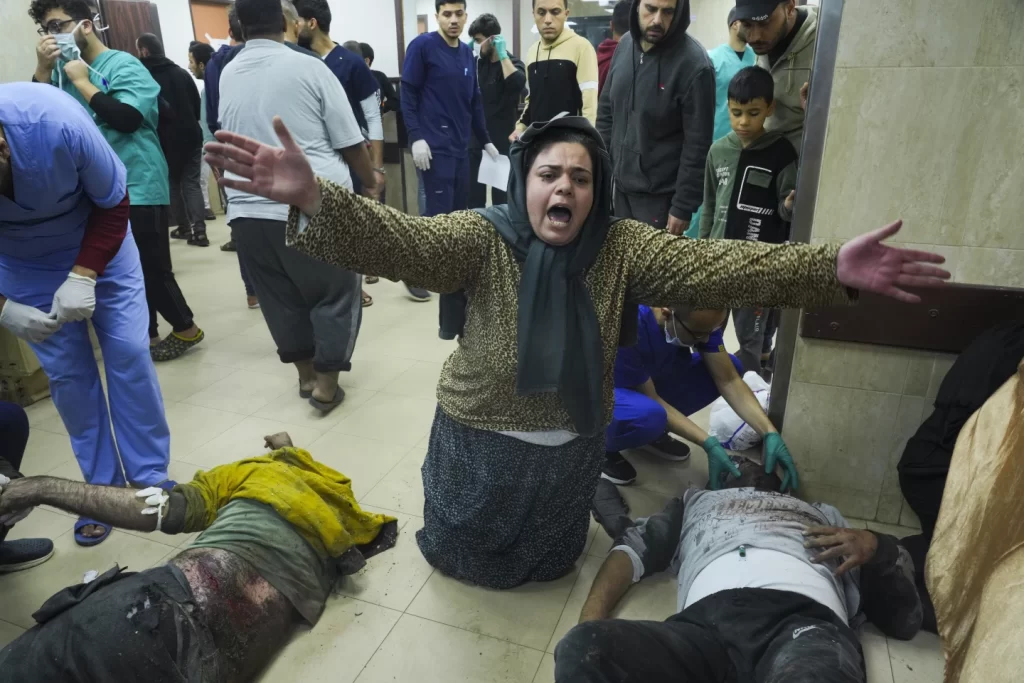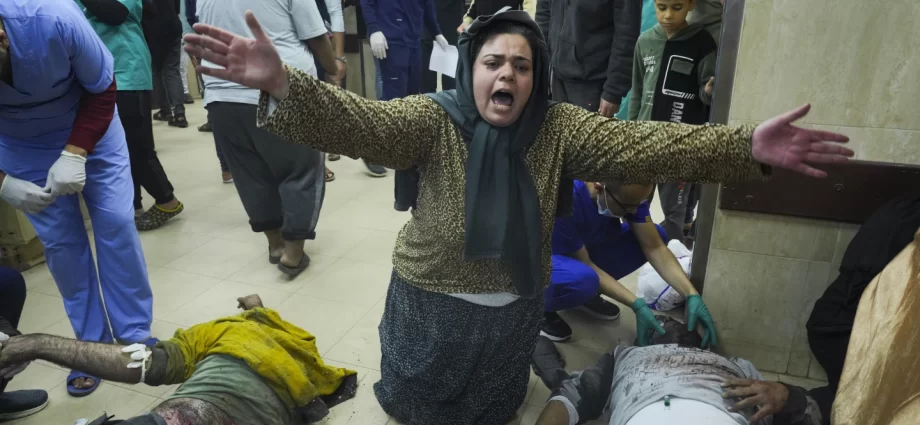
Heavy bombardment followed evacuation orders, and Palestinians said they were running out of places to go in the sealed-off territory bordering Israel and Egypt. Many of Gaza’s 2.3 million people are crammed into the south after Israel ordered civilians to leave the north in the early days of the war, which was sparked by the Oct. 7 Hamas-led attack in Israel that killed about 1,200, mostly civilians.
The United Nations estimates that 1.8 million Gazans have been displaced. Nearly 958,000 of them are in 99 U.N. facilities in the south, said Juliette Toma, director of communications at the U.N. agency for Palestinian refugees.
Fears of a wider conflict intensified. A U.S. warship and multiple commercial ships came under attack in the Red Sea, the Pentagon said. Yemen’s Iran-backed Houthi rebels claimed attacks on two ships they described as being linked to Israel but did not acknowledge targeting a U.S. vessel.
Senior Hamas official Osama Hamdan said resuming talks with Israel on further exchanges must be tied to a permanent cease-fire.
White House National Security Council spokesman John Kirby told NBC’s “Meet the Press” the U.S. was working “really hard” for a resumption of negotiations.
Israel’s military widened evacuation orders in and around Khan Younis in the south, telling residents of at least five more areas to leave. Residents said the military dropped leaflets calling Khan Younis “a dangerous combat zone” and ordering them to move to the border city of Rafah or a coastal area in the southwest.
But Halima Abdel-Rahman, a widow and mother of four, said she won’t heed such orders anymore. She fled her home in October to an area outside Khan Younis, where she stays with relatives.
The United States, Israel’s closest ally, has urged Israel to avoid significant new mass displacement and do more to protect civilians. U.S. Vice President Kamala Harris told Egypt’s president that “under no circumstances” would the U.S. permit the forced relocation of Palestinians from Gaza or the West Bank, an ongoing siege of Gaza or the redrawing of its borders.
On the ground in Gaza, there was fear and mourning. Outside a Gaza City hospital, a dust-covered boy named Saaed Khalid Shehta dropped to his knees beside the bloodied body of his little brother Mohammad, one of several bodies laid out after people said their street was hit by airstrikes. He kissed him.
“You bury me with him!” the boy cried. A health worker at Al-Ahli Baptist Hospital said more than 15 children were killed.
Israel’s military said its fighter jets and helicopters struck targets in Gaza including “tunnel shafts, command centers and weapons storage facilities.” It acknowledged ”extensive aerial attacks in the Khan Younis area.”
Outside a hospital morgue in Khan Younis, resident Samy al-Najeila carried the body of a child. He said his sons had been preparing to evacuate their home, “but the occupation didn’t give us any time. The three-floor building was destroyed completely, the whole block was totally destroyed.” He said six of the bodies were his relatives.
“Five people are still under the rubble,” he said. “God help us.”
In a video from the same crowded al-Nasser hospital, UNICEF spokesperson James Elder said: “I feel like I’m almost failing in my ability to convey the endless killing of children here.”
Israel says it does not target civilians and has taken measures to protect them, including its evacuation orders. In addition to leaflets, the military has used phone calls and radio and TV broadcasts to urge Gazans to move from specific areas.
The widening offensive likely will further complicate humanitarian aid to Gaza. Wael Abu Omar, a spokesman for the Palestinian Crossings Authority, said 100 aid trucks entered Sunday, but U.N. agencies have said 500 trucks per day on average entered before the war.
The renewed hostilities also heightened concerns for the 137 hostages the Israeli military believes are still being held by Hamas. During the recent truce, 105 hostages were freed, and Israel released 240 Palestinian prisoners. Most of those released by both sides were women and children.
Elsewhere in the region, Lebanon’s militant Hezbollah group said it struck Israeli positions near the tense Lebanon-Israel border. Eight soldiers and three civilians were wounded by Hezbollah fire in the area of Beit Hillel, army radio reported. The military said its artillery struck sources of fire from Lebanon and its fighter jets struck other Hezbollah targets.
Iraqi militants with the Iran-backed umbrella group the Islamic Resistance in Iraq said they struck the Kharab al-Jir U.S. military base in Syria with rockets. A U.S. military official, speaking on condition of anonymity in line with regulations, said rockets hit Rumalyn Landing Zone in Syria but there were no reports of casualties or damage.
Later Sunday, officials with Iranian-backed militias in Iraq said five militia members were killed in an airstrike blamed on the U.S. near Kirkuk. The officials spoke on condition of anonymity because they were not authorized to comment publicly. U.S. military officials could not immediately be reached for comment.

